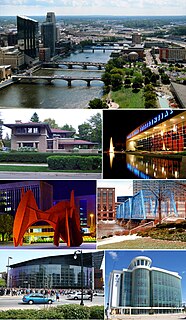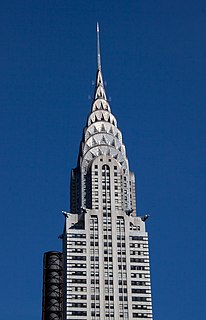
The Merchants Building is a commercial building located at 206 East Grand River Avenue in Downtown Detroit, Michigan. It is also known as the Broadway Merchants Building. It was listed on the National Register of Historic Places in 1983.

11 East Forsyth, formerly known as the Lynch Building and the American Heritage Life Building, is a historic structure in Jacksonville, Florida. Originally developed by Stephen Andrew Lynch, as its current name suggests, it is located at 11 East Forsyth Street in Downtown Jacksonville. On December 23, 2003, it was added to the U.S. National Register of Historic Places.

The Stuber–Stone Building is located at 4221–4229 Cass Avenue in Detroit, Michigan. It was listed on the National Register of Historic Places in 1996. It is now known as the Stuberstone Lofts.

The Trinity Block is a historic commercial building at 266-284 Bridge Street in downtown Springfield, Massachusetts. Built in 1923, the mixed-use retail and office building is noted for its colorful facade, finished in cast stone and terra cotta. It was added to the National Register of Historic Places in 1983.

The Masonic Temple in Kalamazoo, Michigan is a building from 1913. It was listed on the National Register of Historic Places in 1980. No lodges currently meet in the building.

The Elks Temple Building in Cadillac, Michigan was built in 1910 as a lodge meeting hall. It was listed on the National Register of Historic Places in 1988.

The former Yonkers Trolley Barn is located on Main Street in Yonkers, New York, United States. It is a massive steel frame brick building in the Renaissance Revival style built at the beginning of the 20th century. In 2002 it was listed on the National Register of Historic Places as the last remaining trolley barn in Westchester County and the only remnant of Yonkers' trolley system.

The Buckingham Building is a 27-story skyscraper located at 59-67 E. Van Buren St. in the Loop neighborhood of Chicago, Illinois. The building, which opened in 1930, has historically served as a mixed-use retail and office building. Chicago architects Holabird and Root designed the building in the Art Deco style. It was added to the National Register of Historic Places on August 10, 2000.

The Illinois Traction Building, located at 41 E. University Ave. in Champaign, Illinois, was the headquarters of the Illinois Traction System, an interurban railroad serving Central Illinois. Built in 1913, the building held the railway's offices and served as the Champaign interurban station until 1936; it later housed the offices of the Illinois Power Company, which descended from the Illinois Traction System. Architect Joseph Royer planned the building in a contemporary commercial design. The building was added to the National Register of Historic Places on September 20, 2006.

The Terry Hutchens Building is a historic office and apartment building in Huntsville, Alabama. The seven story structure was originally constructed in 1925 for the Tennessee Valley Bank, with office space rented to other tenants. In 2002, the upper floors were renovated into condominiums. The structure is of steel reinforced concrete faced with brick, giving a Gothic Revival appearance. The ground floor façade has large display windows separated by brick piers, and has a central, arched entry covered in masonry. The Jefferson Street façade was originally treated the same way, but was modified with a flat wall of thin brick above two storefront entrances. A decorative band with rowlock course brick and terra cotta panels separate the ground floor from the rest of the building. Above, the piers divide each bay containing a pair of one-over-one sash windows; on the seventh floor, a green terra cotta frog sits on the sill, between the windows. Each bay of the cornice is divided by terra cotta decorated with Gothic shapes and medallions on panels of brick. The building was listed on the National Register of Historic Places in 1980.

The Mason Building is a historic commercial building in Huntsville, Alabama. It was built by the owners of Mason's Furniture, which was founded in 1908. In 1927, they built a new building which they intended to lease to other tenants. It was designed to be built in stages, and be up to five stories tall, but only the first two were ever built. Sears Roebuck began leasing the building in March 1929, at which time a mezzanine and elevator were added. Sears left Huntsville in 1931 in the midst of the Great Depression, and Mason's moved their store into the building. The company operated until 1977; since then, the building has housed a number of businesses, including a pub.

Farmers and Merchants Savings Bank, also known as Union Savings Bank and First Trust and Savings Bank, is an historic building located in Grand Mound, Iowa, United States. It was listed on the National Register of Historic Places in 2001.

Selig's Dry Goods Company Building, also known as Morrisons/Em-roe Sporting Goods Company, is a historic commercial building located at Indianapolis, Indiana. It was built in 1924, and is a seven-story, rectangular, Beaux-Arts style building with a white terra cotta and aluminum front facade. It was remodeled in 1933. The building features tinted plate glass windows and a terra cotta Roman thermal window-like screen at the top floor. The building housed the Selig's Dry Goods Company, in operation until 1933.

Heier's Hotel is a historic hotel building located at Indianapolis, Indiana. It was built in 1915-1916, and is a three-story, five bay, brick building. It features two tall brick piers and terra cotta cornice-like projecting elements. The building houses commercial storefronts on the first floor.

Nickels Arcade is a commercial building located at 326-330 South State Street in Ann Arbor, Michigan. It was listed on the National Register of Historic Places in 1987. The building is notable as perhaps the only remaining example in Michigan of a free-standing commercial arcade building that was popularized by the Cleveland Arcade.

The St. Cecilia Music Center, built in 1894 as the St. Cecilia Society Building, is a performance space located at 24 Ransom Avenue NE in Grand Rapids, Michigan. It was listed on the National Register of Historic Places in 1971. As of 2019, the building continues to house a musical performance space, run by the same organization which built it.

The Exhibitors Building, previously known as the Fine Arts Building, is a commercial office building located at 220 Lyon Street NW in Grand Rapids, Michigan, adjacent to the Amway Grand Plaza Hotel. It was listed on the National Register of Historic Places in 1982.

The Grand Rapids Savings Bank Building is an office building located at 60 Monroe Center, NW, in Grand Rapids, Michigan. It was listed on the National Register of Historic Places in 1990.

The Aldrich, Godfrey, and White Block is a commercial building located at 89-99 Monroe Center in Grand Rapids, Michigan. It was listed on the National Register of Historic Places in 1999.

The Peck Block is a commercial building located at 34-50 Monroe Center NW in Grand Rapids, Michigan. It was listed on the National Register of Historic Places in 2000. The building has been rehabilitated to house condos on the upper floors.



























